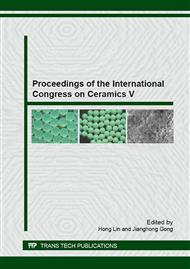[1]
V. S. Vishnu, M. L. Reddy, Near-infrared reflecting inorganic pigments based on molybdenum and praseodymium doped yttrium cerate: Synthesis, characterization and optical properties, Sol. Energy Mater. Sol. Cells. 95 (2011) 2685-2692.
DOI: 10.1016/j.solmat.2011.05.042
Google Scholar
[2]
A.J. Han, M.C. Zhao, M.Q. Ye, J.J. Liao, Z.M. Zhang, N. Li, Crystal structure and optical properties of YMnO3 compound with high near-infrared reflectance, Sol. Energy. 91 (2013) 32-36.
DOI: 10.1016/j.solener.2013.01.011
Google Scholar
[3]
R. Levinso, P. Berdahl, H. Akbari, Solar spectral optical properties of pigments—Part I: model for deriving scattering and absorption coefficients from transmittance and reflectance measurements, Sol. Energy Mater. Sol. Cells. 89 (2005) 319-349.
DOI: 10.1016/j.solmat.2012.07.007
Google Scholar
[4]
J.Y. Liu, Y.M. Lu, J. Liu, X.Y. Yang, X.B. Yu, Investigation of near infrared reflectance by tuning the shape of SnO2 nanoparticles, J. Alloys Compd. 496 (2010) 261-264.
DOI: 10.1016/j.jallcom.2010.01.053
Google Scholar
[5]
T. Masui, T. Honda, Wendusu, Nobuhito Imanaka, Novel and environmentally friendly (Bi, Ca, Zn)VO4 yellow pigments, Dyes Pigments. 99 (2013) 636-641.
DOI: 10.1016/j.dyepig.2013.06.030
Google Scholar
[6]
R.A. Candeia, M.I.B. Bernardi, E. Longo, I.M.G. Santos, A.G. Souza, Synthesis and characterization of spinel pigment CaFe2O4 obtained by the polymeric precursor method, Mater. Lett. 58 (2004) 569-572.
DOI: 10.1016/s0167-577x(03)00563-9
Google Scholar
[7]
M.I.B. Bernardi, S. Cava, C.O. Paiva-Santos, E.R. Leite, C.A. Paskocimas, E. Longo, Comparison of blue pigments prepared by two different methods, J. Eur. Ceram. Soc. 22 (2002) 2911-2919.
DOI: 10.1016/s0955-2219(02)00057-2
Google Scholar
[8]
L. SandhyaKumari, P. PrabhakarRao, A. Narayana Pillai Radhakrishnan, Vineetha James, S. Sameera, PeterKoshy, Brilliant yellow color and enhanced NIR reflectance of monoclinic BiVO4 through distortion inVO4 3- tetrahedral, Sol. Energ. Mat. Sol. C. 112 (2013).
DOI: 10.1016/j.solmat.2013.01.022
Google Scholar
[9]
G. George, V.S. Vishnu, M.L.P. Reddy, The synthesis, characterization and optical properties of silicon and praseodymium doped Y6MoO12 compounds: Environmentally benign inorganic pigments with high NIR reflectance, Dyes Pigments. 88 (2011).
DOI: 10.1016/j.dyepig.2010.05.010
Google Scholar
[10]
P. Sulcova, M. Trojan. Thermal analysis of the Bi2O3-Y2O3-ZrO2 pigments. J. Therm. Anal. Calorim. 93 (2008) 795-798.
DOI: 10.1007/s10973-008-9205-x
Google Scholar


